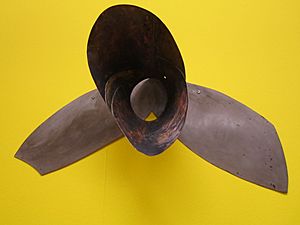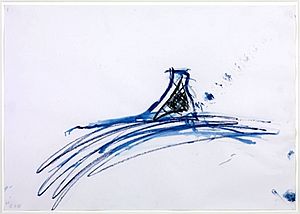Alison Wilding facts for kids
Quick facts for kids
Alison Wilding
|
|
|---|---|

'On the Day' by Alison Wilding
|
|
| Born | 1948 (age 76–77) Blackburn, Lancashire, U.K.
|
| Nationality | British |
| Known for | Sculpture |
Alison Wilding is a famous British artist. She is well-known for creating amazing abstract sculptures. These sculptures are often made from many different materials. Her art has been shown in galleries all around the world.
Contents
About Alison Wilding
Alison Wilding was born in Blackburn, England, in 1948. She loved art from a young age. She studied art at several colleges. These included Nottingham College of Art and the Royal College of Art in London.
Her career really took off in the 1980s. She became part of a group of talented sculptors. In 2019, she received a special award. She was made an Officer of the Order of the British Empire (OBE). This was for her great contributions to art.
Since 2018, she has been a professor. She teaches drawing at the Royal Academy Schools. Alison Wilding lives and works in London.
Alison Wilding's Art and Career
Alison Wilding became interested in sculpture early on. She was inspired by artists like Constantin Brâncuși. He used simple shapes in his sculptures.
She uses many different materials in her art. Some are traditional, like wood, stone, and bronze. But she also uses unusual things. These include steel, wax, silk, and rubber. She often mixes them in surprising ways. For example, her piece Stormy Weather (1987) uses pigment, beeswax, and oil. These are rubbed into galvanised steel. Alison likes to use "stuff" rather than specific materials.
Her sculptures often combine two different materials. These materials might represent opposite ideas. This helps create a sense of balance in her art. She also tries to avoid waste. She wants all her artwork to be displayed.
Alison keeps detailed notes about her work. She gives each piece a unique number and description. These notes include early designs and how she made the art.
Besides sculptures, she also creates many drawings. She enjoys drawing because it feels free. She says drawings are not "weighed down by the material world." This allows her imagination to soar.
Alison Wilding's art is not about politics. She believes art doesn't change lives in the same way a film might. Her decisions about her work are often based on the moment.
Her first solo art show was in 1985. It was at the Serpentine Galleries in London. Later, her work was shown at the Museum of Modern Art in New York.
In 1991, a big show of her work happened. It was called Alison Wilding: Immersion – Sculpture from Ten Years. This show was at Tate Liverpool. She was nominated for the Turner Prize twice. This is a very important art award. She also became a Royal Academician in 1999.
One of her large public artworks was "Ambit." It was a necklace of steel tubes. It floated in the River Wear in Sunderland. It was lit up at night. This artwork was later removed in 2014.
Alison Wilding has won several awards. These include a Paul Hamlyn award in 2008. She also won the Charles Wollaston Award. This award is for the best work in the Royal Academy's summer exhibition.
Exhibitions and Awards
Alison Wilding's art has been shown in many places. She has had many solo exhibitions. These are shows where only her work is displayed. She has also been part of many group exhibitions. These shows feature art from several different artists.
Solo Exhibitions (Selected)
- Young Friends of the Tate Gallery, Tate Gallery, London, UK (1970)
- Sculpture (with Shirazeh Houshiary), Kettle's Yard, Cambridge, UK (1982)
- Serpentine Gallery, London, UK (1985)
- Projects: Alison Wilding, Museum of Modern Art, New York, USA (1987)
- Immersion, Sculpture from Ten Years, Tate Gallery, Liverpool, UK (1991)
- Ambit, The Mattress Factory Art Museum, Pittsburgh PA, USA (1994)
- Alison Wilding: Migrant, Peter Pears Gallery and Snape Maltings, Aldeburgh, UK (2003)
- Deep Water, The Whitworth Art Gallery, Manchester, UK (2013)
- Alison Wilding, Tate Britain, London (2013)
- Right Here and Out There, De La Warr Pavilion, Bexhill-on-Sea, UK (2018)
Group Exhibitions (Selected)
- Six Sculptors, Riverside Studios, London, UK (1978)
- The Sculpture Show, Serpentine Gallery, London, UK (1983)
- The British Art Show, Arts Council of Great Britain, touring UK (1984)
- Starlit Waters: British Sculpture, 1968–88, Tate Gallery, Liverpool, UK (1988)
- The Tuner Prize 1992: Grenville Davey, David Tremlett, Damien Hirst, Alison Wilding, Tate Gallery, London, UK (1992)
- Material Culture: The Object in British Art of the 1980s and 1990s, Hayward Gallery, London, UK (1997)
- Sculpture in the Close, Jesus College, Cambridge, UK (2003)
- How to Improve the World: 60 Years of British Art in the Arts Council Collection, Hayward Gallery, London, UK (2006)
- Drawing: Sculpture, Leeds Art Gallery, Leeds, UK (2012)
- Sculpture as Object, Duveens BP Collection Display, Tate Britain, London, UK (2016)
- Women of the Royal Academy RA250, Abbot Hall Gallery, Kendal, UK (2018)
Awards and Recognition
- GLAA Award (1981)
- Nominated for Turner Prize (1988, 1992)
- Henry Moore Fellowship, The British School at Rome (1989)
- Elected to Royal Academy of Arts (2001)
- Paul Hamlyn Foundation Award (2008)
- Joanna Drew Travel Award (2007)
- Officer of the Order of the British Empire (OBE) (2019)
Art in Collections
Alison Wilding's sculptures and drawings are held in many important art collections. These include:
- Arts Council of Great Britain
- British Council
- Tate Britain
- Art Gallery of New South Wales, Australia
- Scottish National Gallery, UK
- Leeds Art Gallery, UK
- British Museum
- Victoria and Albert Museum, London, UK
Selected Books About Alison Wilding
- Alison Wilding (2018): This book is the first major study of her work.
- Alison Wilding: Art School Drawings from the 1960s and 70s (2011): This book shows her early drawings.
- Alison Wilding: Tracking (2008): This book includes essays about her art.


